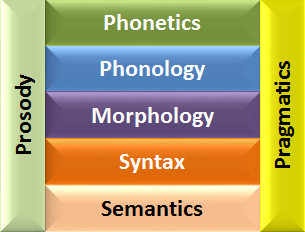05 May A Slice of Language
 A Different Approach
A Different Approach
The previous section explained why we need the ground-up formulation of a new grammar for Natural Language (NL) understanding: none of the existing ones can accommodate the high demands of modern technology and approximate the paradigm of artificial intelligence as a model for human linguistic competence and performance across all linguistic phenomena. In fact, we may even say that we go beneath the ground in that we begin with an understanding of the meaning behind the words. There is a European school of thought that attempts to define a pragmatics-based model for spanning the range of linguistic phenomena (Huang 2007). This is interesting because discourse pragmatics is also deeply concerned with how meaning in context impacts understanding.
In addition to focusing on words first, then sentences later, it may be useful to look beyond the comfortable and mathematically regular syntactic rules with which we are familiar and look for other characteristics of language that can help us get closer to an understanding of what was in the mind of the speaker.
| Understanding Context Cross-Reference |
|---|
| Click on these Links to other posts and glossary/bibliography references |
|
|
|
| Prior Post | Next Post |
| Up from Words to Sentences | Pairs of Language Strata |
| Definitions | References |
| linguistic grammar | Huang 2007 Lamb 1964 |
| Natural Language strata | Bresnan 1978 |
| understanding AI ontology | Small 1980 |
Although 3-D Grammar borrows from several existing formalisms, particularly Lexical Functional Grammar (LFG) and Lexical Interpretive Grammar (Bresnan, 1978), it is unique in its attempt to exploit constraints across the spectrum of linguistic strata. It is also unique in that it is truly word-based (Small, 1980) and thus inherently parallel.
It has been speculated that language actually consists of several levels or strata of distinct features. If this is the case, our knowledge of language would consist of a different type of linguistic knowledge for each stratum.
Theories on the stratificational characteristics of language have been proposed by Gleason and Lamb (1966), who identify several strata of coupled components including semology, syntax, morphology, and phonology.
 A Slice of Language: Language Strata
A Slice of Language: Language Strata
Rivers that slice into rocks expose how many levels there are in the surface of the Earth. As geological strata can provide loads of information to the geologist, linguistic strata can provide helpful information to the language analyst. Unlike rocks, however, linguistic strata are not very useful when detached from each other. In other words, the interaction of language strata is what provides the most information.
Stratificational grammar (Lamb, 1964) is based on the theory that language consists of several hierarchically related layers or strata (see figure at left). The most useful characteristic of each stratum is the way that combinations of units produce or realize units in the next stratum. In spoken language, prosody or phonology is on the surface (perceptual) while pragmatics occupies the greatest depth (conceptual).
In the 3-DG conceptual mosaic, pragmatics consists of relationships between concepts which govern meaning and constrain language. The pragmatics stratum links the linguistic processes of production and comprehension with the cognitive process of reasoning about the world. Pragmatics thus contains both linguistic and conceptual schemata.
In a lexically based formal representation for grammar, the lexicon or dictionary used by the computer to process language is organized from the highest pertinent level downward. In other words, if the system is intended to process textual material, the linguistic surface is morphology (as opposed to a speech interpreter in which phonology is the surface). All information related to a word is then stored in “layers” in the lexicon, built as an ontology, where intelligent links connect data elements.
We have considered the phenomena of language. We may consider some of these as the major Strata of language:
 Prosody: The rhythm, stress, and intonation of speech that leads to understanding subtext and deixis
Prosody: The rhythm, stress, and intonation of speech that leads to understanding subtext and deixis- Phonology: The systematic organization of sounds in languages that are used to assemble sememes and words
- Morphology: The identification, analysis, and description of the structure of morphemes, affixes and roots that change the meanings of words
- Syntax: The way in which words are put together to form phrases, clauses, or sentences – structural analysis and description of word roles and patterns
- Semantics: The meaning or sense of a word, phrase or sentence – often reflecting causal roles such as “agent”, “action”, “instrument”…
- Pragmatics: A subfield of linguistics and semiotics which studies the ways context contributes to meaning – speech acts and discourse are keys
As we attempt to find automated methods that can be used to build a language understanding system, it should be capable of supporting all these processes effectively
| Click below to look in each Understanding Context section |
|---|








